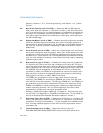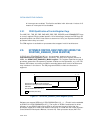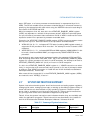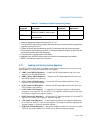
Vol. 3 2-25
SYSTEM ARCHITECTURE OVERVIEW
processor will generate an invalid opcode exception (#UD) if it attempts to
execute any SSE/SSE2/SSE3and instruction, with the exception of PAUSE,
PREFETCHh, SFENCE, LFENCE, MFENCE, MOVNTI, CLFLUSH, CRC32, and
POPCNT. The operating system or executive must explicitly set this flag.
NOTE
CPUID feature flags FXSR indicates availability of the
FXSAVE/FXRSTOR instructions. The OSFXSR bit provides operating
system software with a means of enabling FXSAVE/FXRSTOR to
save/restore the contents of the X87 FPU, XMM and MXCSR registers.
Consequently OSFXSR bit indicates that the operating system
provides context switch support for SSE/SSE2/SSE3/SSSE3/SSE4.
OSXMMEXCPT
Operating System Support for Unmasked SIMD Floating-Point Excep-
tions (bit 10 of CR4) — When set, indicates that the operating system
supports the handling of unmasked SIMD floating-point exceptions through
an exception handler that is invoked when a SIMD floating-point exception
(#XF) is generated. SIMD floating-point exceptions are only generated by
SSE/SSE2/SSE3/SSE4.1 SIMD floating-point instructions.
The operating system or executive must explicitly set this flag. If this flag is
not set, the processor will generate an invalid opcode exception (#UD)
whenever it detects an unmasked SIMD floating-point exception.
VMXE
VMX-Enable Bit (bit 13 of CR4) — Enables VMX operation when set. See
Chapter 20, “Introduction to Virtual-Machine Extensions.”
SMXE
SMX-Enable Bit (bit 14 of CR4) — Enables SMX operation when set. See
Chapter 6, “Safer Mode Extensions Reference” of Intel® 64 and IA-32 Archi-
tectures Software Developer’s Manual, Volume 2B.
OSXSAVE
XSAVE and Processor Extended States-Enable Bit (bit 18 of CR4) —
When set, this flag: (1) indicates (via CPUID.01H:ECX.OSXSAVE[bit 27])
that the operating system supports the use of the XGETBV, XSAVE and
XRSTOR instructions by general software; (2) enables the XSAVE and
XRSTOR instructions to save and restore the x87 FPU state (including MMX
registers), the SSE state (XMM registers and MXCSR), along with other
processor extended states enabled in the XFEATURE_ENABLED_MASK
register (XCR0); (3) enables the processor to execute XGETBV and XSETBV
instructions in order to read and write XCR0. See
Section 2.6 and Chapter
13, “System Programming for Instruction Set Extensions and Processor
Extended States”.
TPL Task Priority Level (bit 3:0 of CR8) — This sets the threshold value corre-
sponding to the highest-priority interrupt to be blocked. A value of 0 means


















